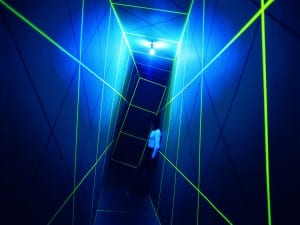Gianni Colombo was a pioneer of kinetic art. He was a restless innovator who saw the pictorial plane as less of a reliable convention and more of an unchartered territory. Colombo’s sculptures eschew the decorative in favour of the aesthetic of modernism, while his installations – or “environments”, as they are known – feel strikingly contemporary. Remarkably for an artist who has exerted such an influence on contemporary practice across European and North American art, this is Colombo’s first UK solo show, having appeared in group shows at the Hayward Gallery and the Venice Biennale during his lifetime. The curators, Francesca Pola and Marco Scotini, have worked with the Archicio Gianni Colombo to bring together a selection of over 30 works, including rare drawings and photographs.
The kinetic works, many of which are not switched on continuously in order to conserve their original motors, have the appearance of three-dimensional expressions of the geometric tradition in 20th century art. They look like iterations of the modernist pictorial plane, with their restrained colour palette and severe lines, but when they spring into action they become something else entirely. Colombo’s first experiment with motorised sculpture, Strutturazione pulsante [Pulsating Structuralisation] (1959), is an innocuous grid of polystyrene blocks, like a monochrome, 3-D Mondrian; but when switched on, it gently pulsates in seemingly random fashion. Suddenly the structure throbs like flesh, flexes and relaxes like muscle, hailing the introduction of the body into an artistic discourse that had hitherto focused on the inhumanity of abstract space.
This is the phenomenological locus of Colombo’s entire project: the body is an extension of space and space is an extension of the body, investigating a unity prevalent in European philosophy throughout the first half of the 20th century. The pure expression of this comes in works that do not even rely on mechanics for their kinetic character. During the 1970s Colombo developed a series of artworks which appear to be wall-hanging sculptures, such as Spazio elastico (bianco) [Elastic Space (White)] (1973), where the viewer is invited to attach the strings of elastic to pins around the perimeter of the circle.
The centrepiece of the exhibition is Topoestesia – zone contigue (itinerario programmato) [Topoesthesia – Three Contiguous Zones (Programmed Itinerary)] (1965-70). Inside it is disorientating, with uneven floors and flashing lights, but as you move through its different zones you become accustomed to the uncertainty of spatial experience. It is here that Colombo most vividly illustrates his underlying assumption that the relationship between body and space is visceral and not intellectual. A series of light-based works reverse the dynamic, since the introduction of light transfers the focus from the object to the viewer, where the kinetic element is the play of shadow. Colombo’s work is the forerunner to the current obsession with interactivity and technology, but, unlike much of what we see today, he retains the hand-made aesthetic of art as something conceptually distinct from the inhuman machine.
Daniel Barnes
Gianni Colombo: The Body and the Space 1959-1980, Robilant + Voena, until 20 November, 38 Dover Street, London, W1S 4NL.
For more information, visit www.robilantvoena.com.
Follow us on Twitter @AestheticaMag for the latest news in contemporary art and culture.
Credits
1. Giani Colombo, Topoestesia – tre zone contigue, 1965-70. Courtesy of the artist and Robilant + Voena.





